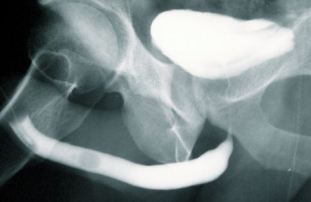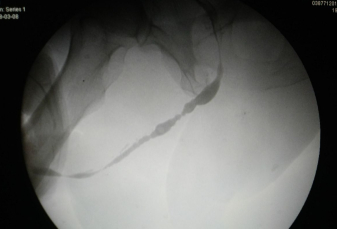Urethroplasty
The Urethra Plasty (urethroplasty) is one of the surgical options to resolve the urethral stricture. Urethral strictures are very frequent processes that develop as a result of trauma or infection (urethritis); they can be single or multiple and affect any urethral segment.
The choice of initial treatment is crucial. It is necessary to base the decision on the treatment to be carried out in an adequate diagnostic evaluation.
 |
 |
| Normal Urethra | Urethral Stricture |
Many years ago, treatment of urethral strictures was performed according to a "treatment ladder" in which all stenoses were treated in the same way, regardless of the location or length of the same.
First a dilatation was carried out; When the stenosis recurred, it was dilated again or treated with one or more internal urethrotomies. These two procedures were often performed in association with intermittent catheterization to try to "stabilize" the urethra. Frequently, these treatments were carried out without an adequate prior diagnostic study. Only when after multiple dilatations and uretrotomies the stenosis did not respond (a very frequent evolution with this treatment) open reconstruction (urethral plasty) was recommended as an option.
This progression from dilation to urethrotomy and from urethrotomy to open surgery was what was known as the "treatment ladder", which is now completely discarded.
The modern approach to urethral stenosis requires a complete prior evaluation and a decision on treatment based on the location and length of the stenosis.Javier Lopez M.D.
Many patients at present have undergone dilatations and urethrotomies without previous diagnostic imaging studies. In addition, many have suffered a series of up to 30 dilatations and / or multiple urethrotomies without having been offered open reconstruction. This management is NOT adequate since it has been proven that it is not always ideal to perform these minimally invasive procedures.
Dilation or urethrotomy may be a valid treatment option in specific cases or to obtain a temporary improvement with the less invasive approach. In many other cases these procedures are not appropriate options. This is especially true when the stenoses are not short, since in them the rates of failure of the dilation or urethrotomy are close to 100%. In addition, the trauma of dilatation or urethrotomy may aggravate the disease.
Open reconstructive surgery of the urethra, performed by surgeons with sufficient experience may be the best option for initial treatment in most cases. Dr. Javier López Rdz conducted a training in this type of surgery in the city of Belgrade, Serbia being supervised by one of the most important surgeons of genital reconstructive surgery (Dr. Rados Djinovic) bringing techniques with excellent results since then.
The excision and anastomosis definitively cure 98% of the cases, this means that it is not necessary to perform catheters or dilatations to maintain the caliber of the urethra. When it is necessary to use pediculated or free grafts, the success rate is a little lower, but it usually heals 80% - 90% of patients.
Our Results
Modern surgical techniques performed by a specialist in urethral reconstruction using the appropriate instruments and equipment are associated with high cure rates and few complications. Dr. Javier López Rdz has focused much of his clinical practice in performing this type of procedure, only in the last year (2017-2018) has managed to perform more than 40 urethral reconstruction surgeries with excellent results.
If you have doubts about your condition and want to know what options you have, contact us with the studies you have (retrograde urethrogram and voiding cystogram) to start your assessment today.



